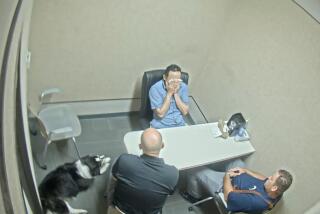Jurors Told Fibers Link Peyer, Knott
- Share via
Three microscopic fibers from the clothing of slain San Diego college student Cara Knott, each invisible to the human eye but each one distinctive in texture and appearance, match fibers found on the gun and boot of former CHP Officer Craig Peyer, two experts testified Monday.
In testimony based on modern forensic science, a police fiber expert also testified that he found three other fibers in Knott’s hands and on her sweat shirt that match fibers taken from Peyer’s CHP jacket patches.
Called Link to Peyer
The findings, prosecutors say, link Peyer to the killing of the 20-year-old San Diego State University student.
Peyer, a 13-year California Highway Patrol veteran, is charged with killing Knott on Dec. 27, 1986. Police said she was strangled after a struggle on the old U.S. 395 bridge near Interstate 15 and the Mercy Road off-ramp between 9 and 10 p.m. Her body was thrown 65 feet into a dry creek bed, where it was discovered by police the next morning. Peyer was arrested and charged with murder Jan. 15, 1987.
San Diego police criminalist John Simms said he used adhesive tape to lift fibers off Peyer’s service revolver April 27, 1987, four months after Knott’s death. Simms said he retrieved two purple fibers that he and another expert said match those taken from the sweat pants that Knott was wearing the night she died.
In addition, Simms said a purple fiber found on Peyer’s left boot also match fibers taken from Knott’s sweat pants.
Two dark fibers recovered from plastic evidence bags that were wrapped around Knott’s hands matched fibers taken from the dark borders of two CHP shoulder patches from Peyer’s jacket, Simms said. The bags were put around Knott’s hands by a deputy coroner at the scene and their contents were examined March 17, 1987.
Evidence on Sweat Shirt
But the most distinctive of the six fibers that prosecutors say link Peyer to the killing was found on Knott’s bloodstained white sweat shirt. Simms testified that a gold fiber with a “rough, pitted, sand-blasted appearance” lifted from the sweat shirt matches the gold thread found in the CHP shoulder patches taken from Peyer’s jacket.
Richard E. Bisbing, an expert in color analysis of fibers, testified that the gold fiber was even more distinctive because of the way it was dyed. Bisbing, who is from Illinois and testified for the prosecution, said the fiber is rayon and dyed with granules added to it at the time of manufacture.
“Finding yellow pigment is unusual,” Bisbing said. “Most fibers are not dyed that way. . . . The yellow fiber from the (sweat) shirt is indistinguishable from those fibers composing the (CHP) shoulder patches.”
Then Bisbing went on to say that his examination of the five other fibers also provided matches. Bisbing examined all six fibers between May 18 and May 20, 1987, at Simms’ request.
Though both Bisbing and Simms testified that the fibers matched each other, neither would say with any certainty that the fibers in question definitely came from the patches or sweat pants.
The incriminating purple fibers produced some controversy Monday, when Simms testified that similarly colored fibers matching those found on Peyer’s gun and boot were found on several fabrics tested in Peyer’s home. In fact, Simms said a pair of dry-cleaned CHP uniforms, still covered in plastic and recovered from Peyer’s house, also had microscopic purple fibers. He also found a purple fiber inside Peyer’s CHP flashlight.
Simms said fibers taken from the dry-cleaned uniform were not tested because they were “contaminated,” prompting defense attorney Robert Grimes to ask whether testing the fibers would have “eliminated the significance” of the purple fibers found on Peyer’s boot and gun.
“Not necessarily,” said Simms, who went on to explain that light-colored purple fibers were eliminated “right off the bat.”
Then Grimes asked whether Peyer’s boot and gun could have been contaminated by the dry-cleaned uniforms that came back from the cleaners with purple fibers on them.
“That goes beyond the scope of my knowledge,” Simms said.
When Simms met with Bisbing in May, he also took purple fibers recovered from Peyer’s home. Bisbing said he tested several purple fibers from different sources, including fibers taken from Knott’s sweat pants, and determined that the purple fibers taken from Peyer’s boot and gun most closely matched the cotton fibers from Knott’s pants.
According to Simms, he used forensic equipment to check the homes of Knott and her boyfriend, Wayne Bautista, on March 19, 1987, and Peyer’s residence on April 6, 1987. The object of the search was to determine whether any gold or dark-colored fabrics in the Knott and Bautista home could explain the gold or dark fabrics recovered from Knott’s body.
Peyer’s House Searched
Peyer’s home was searched in an attempt to explain the purple fibers found on his gun and boot, Simms said.
Some gold and dark-colored fabrics found in the Knott and Bautista homes were “similar” to the fibers recovered from Knott’s body, Simms said. However, further tests proved inconclusive, he added.
During his questioning of Simms, Grimes also attempted to blame “contamination” for the fibers found on Peyer’s gun and boot. Grimes suggested that convection currents, opening or shutting of doors or the closing of evidence bags in the police evidence room could have lifted fibers from Knott’s clothing and landed them on Peyer’s belongings.
But Grimes did manage to get Simms to acknowledge that Peyer’s boots have a distinctive tread design. That design was not found among the numerous shoe prints found in the sand at the bridge where Knott was killed, Simms said.
More to Read
Sign up for Essential California
The most important California stories and recommendations in your inbox every morning.
You may occasionally receive promotional content from the Los Angeles Times.













